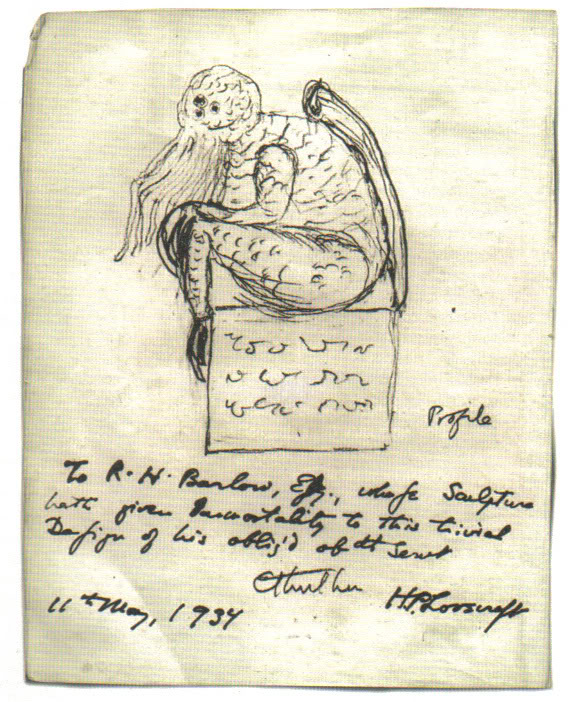 |
| A sketch of Cthulhu made by |
| H. P. Lovecraft in May 1934. |
It represented a monster of vaguely anthropoid outline, but with an octopus-like head whose face was a mass of feelers, a scaly, rubbery-looking body, prodigious claws on hind and fore feet, and long, narrow wings behind. This thing, which seemed instinct with a fearsome and unnatural malignancy, was of a somewhat bloated corpulence, and squatted evilly on a rectangular block or pedestal covered with undecipherable characters.
Cthulhu featured in many of Lovecraft's subsequent stories and inspired many other writers as well. If you write about a monster with tentacles, most horror readers will think you're making reference to Cthulhu.
So, I was surprised when I came across a couple of tales by M. R. James that also feature monsters with tentacles. These are “Count Magnus” and “The Treasure of Abbot Thomas,” both from Ghost Stories of an Antiquary (1904). I won't go into plot summaries as the overall plots aren't relevant to our discussion. What is relevant is that both stories feature monsters with tentacles. Consider the passages below (emphasis mine):
The figure was unduly short, and was for the most part muffled in a hooded garment which swept the ground. The only part of the form which projected from that shelter was not shaped like any hand or arm. Mr Wraxall compares it to the tentacle of a devil-fish, and continues: 'On seeing this, I said to myself, "This, then, which is evidently an allegorical representation of some kind--a fiend pursuing a hunted soul--may be the origin of the story of Count Magnus and his mysterious companion...."'
—from “Count Magnus”
I believe I am now acquainted with the extremity of terror and repulsion which a man can endure without losing his mind. I can only just manage to tell you now the bare outline of the experience. I was conscious of a most horrible smell of mould, and of a cold kind of face pressed against my own, and moving slowly over it, and of several--I don't know how many--legs or arms or tentacles or something clinging to my body.
—from “The Treasure of Abbot Thomas”
I recalled that Lovecraft had praised James in his essay Supernatural Horror in Literature. The real surprise came when I checked out Lovecraft's comments on James and found that the two stories he singled out for longer treatment were “Count Magnus” and “The Treasure of Abbot Thomas.” I've never seen any evidence that Lovecraft drew on James's monsters when creating Cthulhu, but Lovecraft certainly had the stories in his head.
That is fascinating - sounds like some scholarly research needs to be done! The tone of The Treasure of Abbot Thomas is very Lovecraftian isn't it?
ReplyDeleteDefinitely. If I were a scholar I would be scouring Lovecraft's volumes of letters for James references.
DeleteThere is definitely something inherently revolting about tentacles. I think the "Pirates of the Caribbean" modernized this for both the Kraken and the undead Capt. Davy Jones's head, and I imagine countless other movies books have used it too. Very interesting about Lovecraft and James.
ReplyDeleteYup, something slimy with suckers that wraps around you. Ick!!
Delete